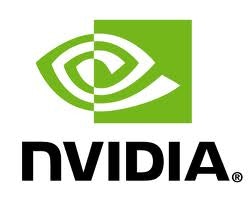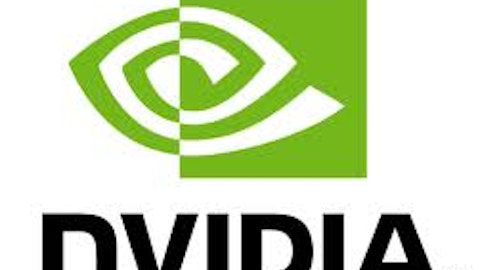Last week, chip maker NVIDIA Corporation (NASDAQ:NVDA) reported strong results for the fourth quarter of its 2013 fiscal year, but provided very weak guidance for next quarter. The weak guidance prevented NVIDIA shares from making a big move, although the stock did post a modest gain for the week. The modest Q1 outlook is the result of a product transition at NVIDIA that is being accentuated by a seasonal slowdown.
NVIDIA’s EPS will probably bottom out this quarter and then rise through the rest of the year as production of the new Tegra 4 mobile processor ramps up. Still, profit is not likely to exceed FY13’s total of $0.90 GAAP/$1.17 non-GAAP in the current year (fiscal year 2014). For investors, patience can be one of the hardest virtues to exercise. However, patience is exactly what NVIDIA investors need right now, as the company is poised for strong growth next year.

There are three main long-term growth drivers for NVIDIA (listed by order of importance): 1. mobile processors, 2. cloud-based GPUs, and 3. professional GPUs. GPUs are graphics processing units. With the Tegra line of mobile processors and Icera modems, NVIDIA plans to challenge QUALCOMM, Inc. (NASDAQ:QCOM) in powering smartphones and tablets. NVIDIA recently invented the cloud-based GPU with a product called “GRID”, which is just beginning to produce revenue. Finally, professional GPUs (the Quadro line of workstation graphics cards and the Tesla line of high-performance computing GPUs) have been a growth category for NVIDIA for a long time, and should continue to provide a tailwind for NVIDIA.
Tegra 4 to the rescue?
The biggest cause of NVIDIA’s weak Q1 forecast is the product transition from Tegra 3 to Tegra 4. NVIDIA introduced Tegra 4 at the Consumer Electronics Show last month, and the chip provides impressive improvements over Tegra 3. Most notably, NVIDIA is finally capitalizing on its graphics expertise for Tegra 4 with 72 custom GeForce GPU cores. The company has stated that it has already achieved more design wins for Tegra 4 than it did for Tegra 3. We are likely to hear about some of those design wins next week at the Mobile World Congress.
The near-term problem for NVIDIA is that it needs to offer an integrated mobile processor (which combines the application processor and modem on one chip) to be competitive in the smartphone market. While the tablet market is also very large, the top two vendors, Apple Inc. (NASDAQ:AAPL) and Samsung, design their own processors. According to IDC, Apple and Samsung combined to produce 59% of the 52.5 million tablets shipped last quarter. Thus, while NVIDIA had numerous tablet design wins last year, including two flagship devices — Google Inc (NASDAQ:GOOG)‘s Nexus 7 and Microsoft Corporation (NASDAQ:MSFT)‘s Surface RT — it was shut out of the best-selling tablets.
By contrast, NVIDIA’s management estimates the market for integrated processors with LTE at 150 million units this year, growing at 50% annually. As my fellow Fool Steve Heller recently observed, Qualcomm made an ambitious bet on integrated apps processors/LTE modems, which put it more than a year ahead of the competition. However, NVIDIA will have caught up by the end of this year with its “Grey” integrated mobile processor, allowing it to compete for high-volume smartphone design wins next year. At that point, Tegra sales growth should really take off, offsetting the heavy research and development expenses NVIDIA has been incurring for the past several years.
GRID: GPU of the future?
Cloud-based GPUs are another growth area for NVIDIA. GeForce GRID involves NVIDIA putting GPUs in a server to remotely run games or business applications. NVIDIA plans to address three main markets: 1. enterprise computing, 2. cloud gaming, and 3. software as a service. In the enterprise market, server-based GPUs will make virtual desktop applications run faster, particularly for tasks such as video or slideshows. This is the only type of GRID server expected to make a significant revenue contribution this year.
Looking further down the road, NVIDIA is working with partners to deliver cloud-based gaming to various connected devices. The game’s graphics would be rendered with server-based GPUs, and then streamed over the Internet to users. Lastly, NVIDIA plans to sell GRID servers to software-as-a-service providers, or SaaS providers. This would enable them to create graphics-intensive applications that would not otherwise be feasible with the cloud-based SaaS model. These three markets could drive substantial demand for high-end GPUs in a few years, but the revenue/earnings impact is likely to be modest this year, particularly because cloud-gaming and SaaS GRID servers will not ramp up until the end of the year.
Professional GPUs
NVIDIA’s last major growth area is in professional GPUs. The Quadro line of professional graphics cards finally returned to growth last quarter, due to the ramp up of new products based on the Kepler architecture. The company had posted disappointing results in that segment in the previous few quarters. NVIDIA is the clear market leader in this category, and as the global economy recovers, business spending should pick up, boosting Quadro sales.
There is a potentially even bigger growth opportunity in high-performance computing. NVIDIA leads this market, too. The company’s Tesla GPUs were selected last year to accelerate the world’s fastest supercomputer, Titan. However, Intel Corporation (NASDAQ:INTC) is entering this market with its new Xeon Phi coprocessor, and could steal some market share from NVIDIA. There is enough room for two competitors in this market, but Intel’s entrance could hurt NVIDIA’s performance in the near-term.
Patience, young grasshopper
NVIDIA has plenty of growth ahead of it. However, pursuing these growth opportunities has required massive R&D investments, which have crimped EPS over the past few years. This dynamic will continue through most of 2013. However, shareholders should be patient, as NVIDIA’s new products will drive faster revenue growth exiting 2013, which could finally allow the company to realize its full potential. Fortunately, NVIDIA is paying a nice 2.4% dividend and has finally restarted its share repurchase program.
The article 2013 Will Be a Year of Waiting for NVIDIA Shareholders originally appeared on Fool.com and is written by Adam Levine-Weinberg.
Fool contributor Adam Levine-Weinberg owns shares of Apple and NVIDIA. The Motley Fool recommends Apple, Google, Intel, and NVIDIA. The Motley Fool owns shares of Apple, Google, Intel, Microsoft, and Qualcomm.
Copyright © 1995 – 2013 The Motley Fool, LLC. All rights reserved. The Motley Fool has a disclosure policy.





